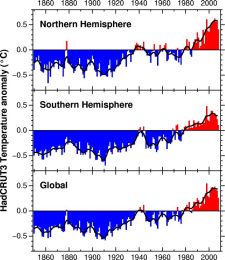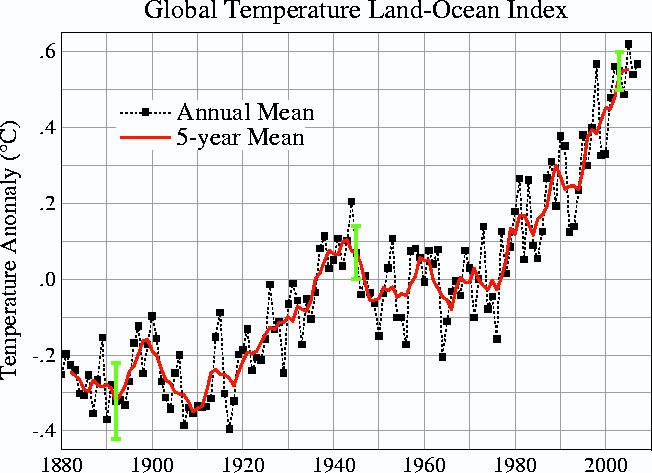As part of their climate myth series, New Scientist cuts through the nonsense on what’s happened globally in the last decade:
In fact, the planet as a whole has warmed since 1998, even in the years when surface temperatures have fallen.
According to the dataset of the UK Met Office Hadley Centre (see figure, right), 1998 was the warmest year by far since records began, but since 2003 there has been slight cooling.
But according to the dataset of NASA’s Goddard Institute for Space Studies (see figure, below fold), 2005 was the warmest since records began, with 1998 and 2007 tied in second place.
The difference between the two datasets goes to the core of why the planet has in fact been warming since 1998:
The main reason is that there are no permanent weather stations in the Arctic Ocean, the place on Earth that has been warming fastest. The Hadley record simply excludes this area, whereas the NASA version assumes its surface temperature is the same as that of the nearest land-based stations.
It is possible that the NASA approach underestimates the rate of warming in the Arctic Ocean, but for the sake of argument let’s assume that the Hadley record is the most accurate reflection of changes in global surface temperatures. Doesn’t it show that the world has cooled since the record warmth of 1998, as many claim?
Not necessarily. The Hadley record is based only on surface temperatures, so it reflects only what’s happening to the very thin layer where air meets the land and sea.
In the long term, what matters is how much heat is gained or lost by the entire planet – what climate scientists call the “top of the atmosphere” radiation budget – and falling surface temperatures do not prove that the entire planet is losing heat.
… the planet is gaining as much heat from the sun as usual but losing less heat every year as greenhouse gas levels rise (apart from the exceptional periods after major volcanic eruptions, such as El Chichon in 1982 and Pinatubo in 1991).
How do we know? Because the oceans are getting warmer.
Tricky oceans
Water stores an immense amount of heat compared with air. It takes more than 1,000 times as much energy to heat a cubic metre of water by 1 degree Centigrade as it does the same volume of air. Since the 1960s, over 90% of the excess heat due to higher greenhouse gas levels has gone into the oceans, and just 3% into warming the atmosphere (see figure 5.4 in the IPCC report (PDF)).
Globally, this means that if the oceans soak up a bit more heat energy than normal, surface air temperatures can fall even though the total heat content of the planet is rising. Conversely, if the oceans soak up less heat than usual, surface temperatures will rise rapidly.
This is why surface temperatures do not necessarily rise steadily year after year, even though the planet as a whole is heating up a bit more every year. Most of the year-to-year variability in surface temperatures is due to heat sloshing back and forth between the oceans and atmosphere, rather than to the planet as a whole gaining or losing heat.
The record warmth of 1998 was not due to a sudden spurt in global warming but to a very strong El Nino (see figure). In normal years, trade winds keep hot water piled up on the western side of the tropical Pacific.
During an El Nino, the winds weaken and the hot water spreads out across the Pacific in a shallow layer, which increases heat transfer to the atmosphere. (During a La Nina, by contrast, as occurred during the early part of 2008, the process is reversed and upwelling cold water in the eastern Pacific soaks up heat from the atmosphere.)
A temporary fall in the heat content of the oceans at this time may have been due to the extra strong El Nino.
What next?
Since 1999, however, the heat content of the oceans has steadily increased again (despite claims to the contrary). Global warming has certainly not stopped, even if average surface temperatures really have fallen slightly as the Hadley figures suggest.
If you want to know what’s coming next, read this.
This post was created for ClimateProgress.org, a project of the Center for American Progress Action Fund.



